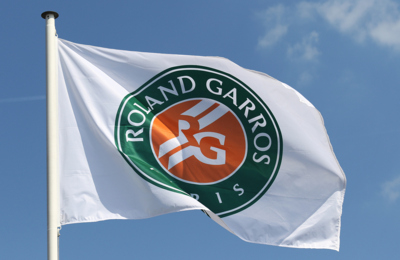
The French Open is one of the highlights of the tennis calendar. It makes up one of the four Grand Slams, the tennis majors, alongside the Australian Open, US Open and Wimbledon. It’s a tournament that if won, can immortalise a player as one of the true greats of the game, such is its stature.
The tournament has been held at numerous venues in the early years, but since 1928 it has resided at Roland Garros, Paris. The courts that they play on there are all clay, but there was a time when these courts were actually sand, believe it or not. They are the only one of the four majors that are currently played on clay.
- In This Article:
- About
- Surface
- Courts
- Prize Money
- Statistics
- History
French Open Recent Winners
| Year | Men's Winner | Men's Runner-Up | Women's Winner | Women's Runner-Up |
|---|---|---|---|---|
| 2023 | Novak Djokovic | Casper Ruud | Iga Swiatek | Karolina Muchova |
| 2022 | Rafael Nadal | Casper Ruud | Iga Swiatek | Coco Gauff |
| 2021 | Novak Djokovic | Stefanos Tsitsipas | Barbora Krejcikova | Anastasia Pavlyuchenkova |
| 2020 | Rafael Nadal | Novak Djokovic | Iga Swiatek | Sofia Kenin |
| 2019 | Rafael Nadal | Dominic Thiem | Ashleigh Barty | Marketa Vondrousova |
| 2018 | Rafael Nadal | Dominic Thiem | Simona Halep | Sloane Stephens |
| 2017 | Rafael Nadal | Stan Wawrinka | Jelena Ostapenko | Simona Halep |
| 2016 | Novak Djokovic | Andy Murray | Garbine Muguruza | Serena Williams |
| 2015 | Stan Wawrinka | Novak Djokovic | Serena Williams | Lucie Safarova |
| 2014 | Rafael Nadal | Novak Djokovic | Maria Sharapova | Simona Halep |
| 2013 | Rafael Nadal | David Ferrer | Serena Williams | Maria Sharapova |
| 2012 | Rafael Nadal | Novak Djokovic | Maria Sharapova | Sara Errani |
| 2011 | Rafael Nadal | Roger Federer | Li Na | Francesca Schiavone |
| 2010 | Rafael Nadal | Robin Soderling | Francesca Schiavone | Samantha Stosur |
| 2009 | Roger Federer | Robin Soderling | Svetlana Kuznetsova | Dinara Safina |
| 2008 | Rafael Nadal | Roger Federer | Ana Ivanovic | Dinara Safina |
| 2007 | Rafael Nadal | Roger Federer | Justine Henin | Ana Ivanovic |
| 2006 | Rafael Nadal | Roger Federer | Justine Henin | Svetlana Kuznetsova |
| 2005 | Rafael Nadal | Mariano Puerta | Justine Henin | Mary Pierce |
| 2004 | Gaston Gaudio | Guillermo Coria | Anastasia Myskina | Elena Dementieva |
About the French Open at Roland-Garros
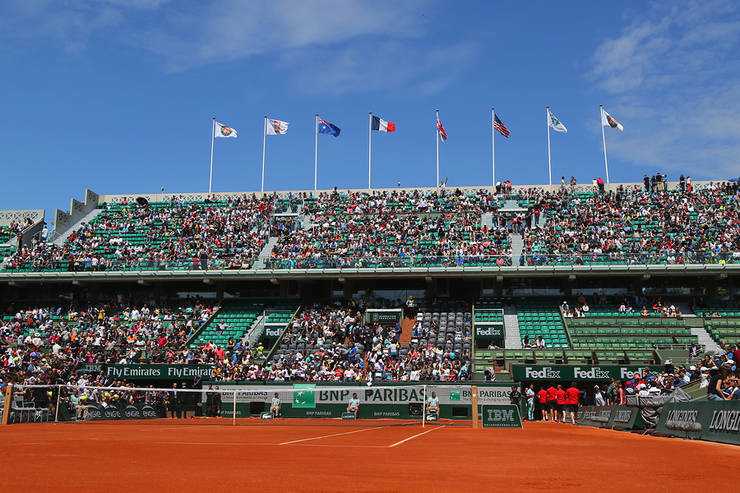
What’s unique about the French Open is that theoretically any player can qualify for the event. There are a number of spots that are reserved for player with certain world rankings, but via a series of qualifiers, a host of players are able to make it through. It’s a bit like a David v Goliath story, especially in the earlier rounds where top seeds play bottom or unseeded players in what’s often the biggest match of their lives.
There are 32 seeds that are distributed in the men’s and women’s games. This is loosely based on World ranking points over the previous year and past performances within the past 12 months, but it is essentially down to the committee of the event to determine who is seeded and where.
The whole concept of seeding players is to give players with a higher rank a reward for being so, often playing lower ranked players along the way. The top 2 players are drawn at different ends of the draw, so theoretically if they both win all their matches, they will meet in the final.
There are essentially 8 sections within each draw, although everyone is linked as a knock out format. So, seed number 1 will be the top player in Section 1 and seed number 2 will be the top ranked player in Section 8. The top 8 players will then be assigned a section each. Then the next players ranked from 9-16 will also be added to each group.
With each set of groups of rankings, say from 17-24, 25-32 and so on will be assigned one player from that bracket into each group. After each of the top 32 players have been assigned groups, the draw becomes a little more random, with qualifiers and wild cards being assigned places in each group.
There are 16 qualifiers in total, with 1 Lucky Loser from the event, who is essentially drawn at random from the losing finalists within the qualifying process. There are also a number of different groups of players that are able to win trophies, which include:
- Men’s Singles
- Women’s Singles
- Men’s Doubles
- Women’s Doubles
- Mixed Doubles
For each of the events there will be a trophy awarded to the winner along with a cheque, granted to either the individual or the team in the case of doubles and mixed doubles. The prizemoney for the men’s and women’s singles is the same these days, with the record prize fund in 2022 where the prize fund topped €43 million to be paid out overall, .
The Surface
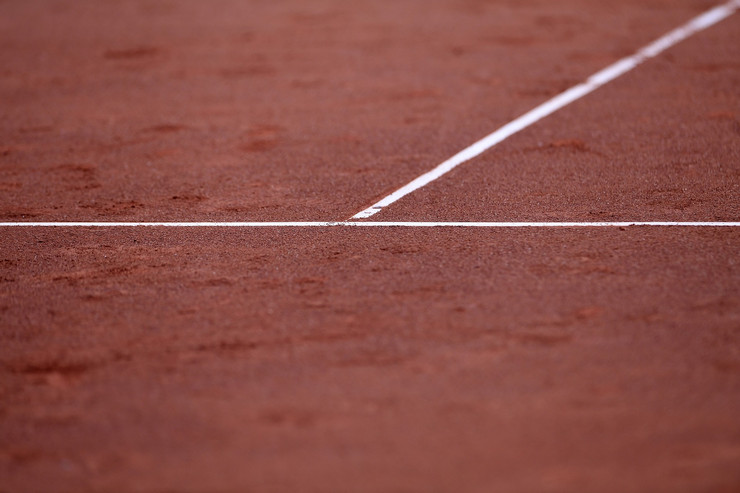
As the French Open is the only one of the majors that is played on clay, it is seen as something of a specialist surface. Although, there are much more regular tour events played on clay than say there is grass for example, so it’s not totally alien to most players.
What you will find is that the ball reacts different on clay than most other surfaces. It comes off the surface rather slowly, which means that it requires a particular set of skills to be successful on there. For example, grass is often thought of as being fairly quick and provides a lot of bounce, so players with big serves have often done well there. But, on clay the bounce is lower and the ball reacts slower off the clay, meaning that the serve is not as effective as it might be.
With clay, players need to be both very fit and almost have a dogged approach to the game. Rafael Nadal is the epitome of this and this is the main reason why he is the most successful men’s player at the French Open. Compare this to someone like Pete Sampras, who won seven Wimbledon championships, but never won a French Open.
It’s also worth noting that as the clay actually marks where the ball lands, hawk eye isn’t actually used and instead they go off the umpire’s judgement. If a call is close, it’s not uncommon for the umpire to exit his chair and look closer at the court to see if a mark has been made. The pressure to utilise the technology is growing though, with many people arguing that they may as well use it if it’s there, so in years to come this might change.
The Courts

The Rolland Garros estate covers over 21 acres and with it, 20 courts are available for use throughout the 2 weeks of the French Open. There are three main stadium courts though, that are Court Philippe Chatrier, Court Suzanne Lenglen and simply, Court 1.
The main court is that of Court Philippe Chatrier, which was built in 1928 and was the first court within the establishment. It seats over 14,000 and creates one of the most intimidating atmospheres in tennis, mainly down to the fact that the seats are so close to the court. The court is named after the French Tennis Federations long-time President, who was also a pioneer in getting tennis back into the Olympics in 1988.
Court Suzanne Lenglen is slightly smaller in stature, holding just over 10,000 people and was built in 1994. The court is named after one of the most successful women’s tennis players of all time. Lenglen managed to win both The French Open and Wimbledon on 6 different times each, also winning two gold medals in Antwerp in 1920.
Finally, court 1 has actually been about since 1980, but has undergone some extensive renovation work during that time to really make it one of the feature courts. It only holds 3,800 fans, but it’s another of their stadiums that are cauldron-like, with the feeling that the fans are almost sat on top of you when it’s full. It’s also seen as a bit of a seeded graveyard, with some huge upsets to have taken place there over the years.
Prize Money
The prizemoney on offer at the 2021 French Open will be €43.6 million an increase of around €9 million from the previous tournament in 2021 which was around €34 million. It’s worth noting that in since the 2015 tournament this has increased markedly from €28 million. The money is split equally between the men’s and the women’s game, working the same for doubles and mixed doubles. Depending on where you finish in an event will depend on the money that you get.
Below is how the men’s and women’s singles, doubles and mixed doubles prize money breakdown per round of the French Open, calculated in Euros. For doubles and mixed doubles events, the money is given to the pair of players and it can then be divided however they wish.
French Open Prize Money in 2022
| Stage Eliminated | Singles | Doubles | Mixed Doubles |
|---|---|---|---|
| Qualifying Round 1 | €10,000 | – | – |
| Qualifying Round 2 | €16,000 | – | – |
| Qualifying Round 3 | €25,600 | – | – |
| Round 1 | €62,000 | €15,500 | €10,000 |
| Round 2 | €86,000 | €25,000 | – |
| Round 3 | €125,800 | €42,000 | – |
| Round 4 | €220,000 | – | – |
| Quarter-final | €380,000 | €79,500 | €17,500 |
| Semi-final | €600,000 | €146,000 | €31,000 |
| Runner-up | €1,100,000 | €290,000 | €61,000 |
| Winner | €2,200,000 | €580,000 | €122,000 |
Men’s Singles Statistics
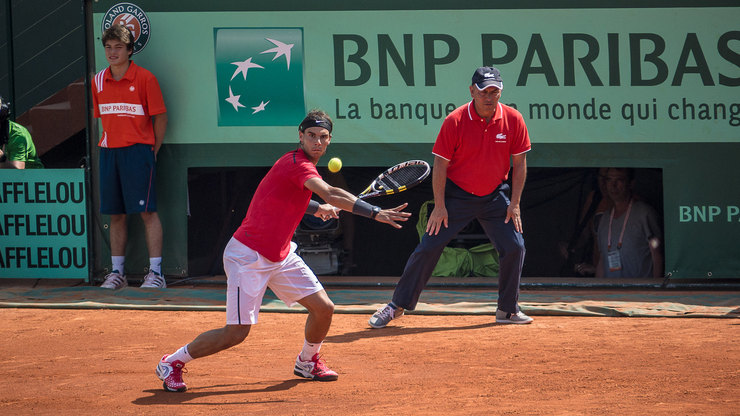
As the French Open is played on clay courts, there will be players whose style of play suits the surface. Below we look at some of the records at the French Open as well as those who have won major clay titles in recent years.
The most successful player in the men’s game in the modern era of the French Open (from 1925 onward) is that of Spaniard, Rafael Nadal, winning the tournament on 13 occasions from 2005 through his latest, 2020.
The youngest men’s winners to date is Michael Chang, aged just 17 years and 3 months. Chang however would never go on to win another major title.
In the amateur era before that of 1968, the French absolutely dominated the event, with 37 wins. But, since the Open era started, they have only been able to win the tournament once, with that of Yannick Noah winning in 1983 against Swede, Mats Wilander.
Within the open era, the Europeans have dominated the French Open though, with Spain leading the line on 19 wins, mainly down to Rafael Nadal’s 12 wins. The United States players have found clay notoriously difficult to adjust to and with it only 3 players have prospered on the surface, Andre Agassi, Jim Courier and Michael Chang.
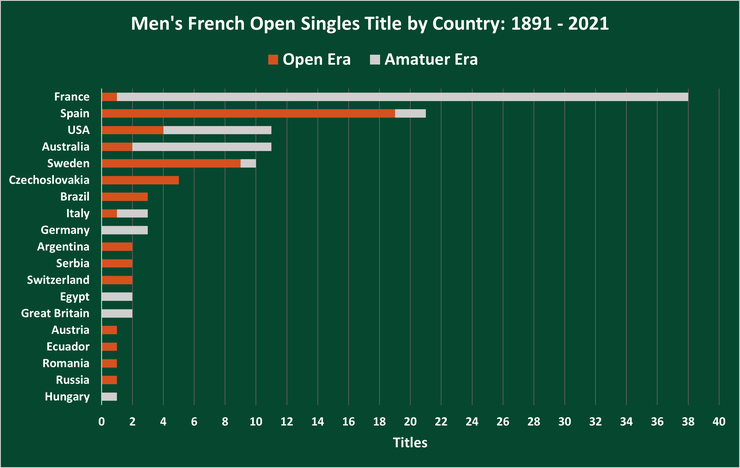
The French Open tournament is by far the biggest the biggest clay court fixture in the season but the ATP 1000 events of the Monte-Carlo Masters, Madrid Open and the Italian Open give an indication of who is in form in the lead up to Roland Garros. Rafael Nadal has regularly been joined in the latter stages of these tournaments by Novkak Djokovic, Alexander Zverev and Dominic Thiem in recent seasons.
Major Men’s ATP Clay Titles: 2002 – 2022
| Year | Italian Open | Madrid Open | Monte-Carlo Masters |
|---|---|---|---|
| 2022 | Novak Djokovic | Carlos Alcaraz | Stefanos Tsitsipas |
| 2021 | Rafael Nadal | Alexander Zverev | Stefanos Tsitsipas |
| 2020 | Novak Djokovic | Cancelled | Cancelled |
| 2019 | Rafael Nadal | Novak Djokovic | Fabio Fognini |
| 2018 | Rafael Nadal | Alexander Zverev | Rafael Nadal |
| 2017 | Alexander Zverev | Rafael Nadal | Rafael Nadal |
| 2016 | Andy Murray | Novak Djokovic | Rafael Nadal |
| 2015 | Novak Djokovic | Andy Murray | Novak Djokovic |
| 2014 | Novak Djokovic | Rafael Nadal | Stan Wawrinka |
| 2013 | Rafael Nadal | Rafael Nadal | Novak Djokovic |
| 2012 | Rafael Nadal | Roger Federer | Rafael Nadal |
| 2011 | Novak Djokovic | Novak Djokovic | Rafael Nadal |
| 2010 | Rafael Nadal | Rafael Nadal | Rafael Nadal |
| 2009 | Rafael Nadal | Roger Federer | Rafael Nadal |
| 2008 | Novak Djokovic | Andy Murray | Rafael Nadal |
| 2007 | Rafael Nadal | David Nalbandian | Rafael Nadal |
| 2006 | Rafael Nadal | Roger Federer | Rafael Nadal |
| 2005 | Rafael Nadal | Rafael Nadal | Rafael Nadal |
| 2004 | Carlos Moya | Marat Safin | Guillermo Coria |
| 2003 | Felix Mantilla | Juan Carlos Ferrero | Juan Carlos Ferrero |
| 2002 | Andre Agassi | Andre Agassi | Juan Carlos Ferrero |
Women’s Singles Statistics
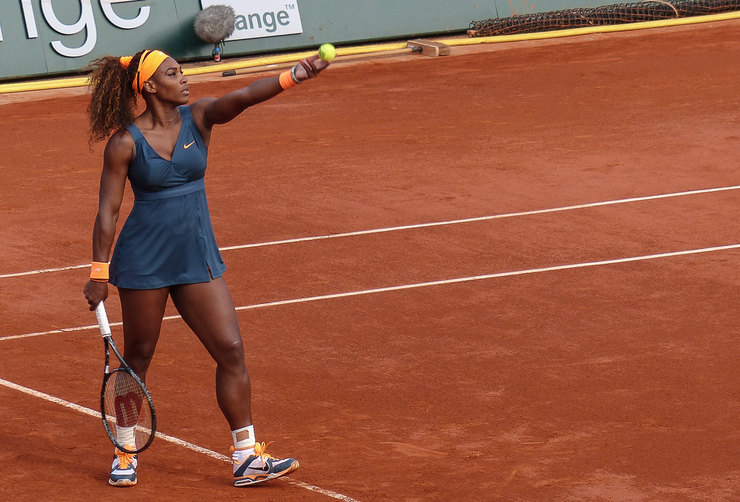
In the women’s game, Chris Evert has been most the successful player at Roland Garros, with 7 wins to her name, spanning from 1974 through to 1986.
The youngest women’s winner is Monica Seles no less, winning at just 16 years and 6 months. Seles saw 2 more wins at the French with 9 major wins to her name in total when she finally retired in 2008.
Overall, the women’s side of this is actually almost the total opposite of the men’s, with the United States winning more than 3 times more than any other nation in the open era, with 15 titles. But, they also hold 14 wins from the pre-open era as well, so it’s a tournament where they have always seen success. The catalysts behind their dominance has come in the form of Chris Evert, Serena Williams and Martina Navratilova.
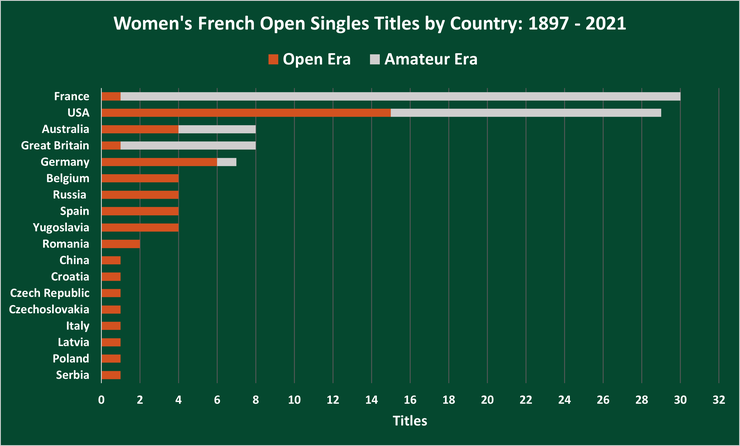
The Italian Open and Madrid Open also provide the key women’s clay court tournaments as preparation for the French Open. In recent seasons Simona Halep, Elina Svitolina and Petra Kvitova have all been victorious in these events.
Major Women’s WTA Clay Titles: 2002 – 2022
| Year | Italian Open | Madrid Open |
|---|---|---|
| 2022 | Iga Swiatek | Ons Jabeur |
| 2021 | Iga Swiatek | Aryna Sabalenka |
| 2020 | Simona Halep | Cancelled |
| 2019 | Karolina Pliskova | Kiki Bertens |
| 2018 | Elina Svitolina | Petra Kvitova |
| 2017 | Elina Svitolina | Simona Halep |
| 2016 | Serena Williams | Simona Halep |
| 2015 | Maria Sharapova | Petra Kvitova |
| 2014 | Serena Williams | Maria Sharapova |
| 2013 | Serena Williams | Serena Williams |
| 2012 | Maria Sharapova | Serena Williams |
| 2011 | Maria Sharapova | Petra Kvitova |
| 2010 | Maria Jose Martinez Sanchez | Aravane Rezai |
| 2009 | Dinara Safina | Dinara Safina |
| 2008 | Jelena Jankovic | No tournament |
| 2007 | Jelena Jankovic | No tournament |
| 2006 | Martina Hingis | No tournament |
| 2005 | Amelie Mauresmo | No tournament |
| 2004 | Amelie Mauresmo | No tournament |
| 2003 | Kim Clijsters | No tournament |
| 2002 | Serena Williams | No tournament |
History of the French Open
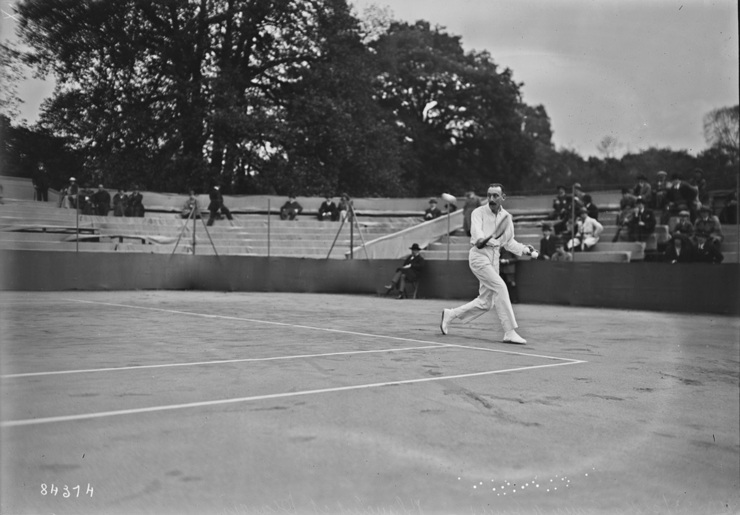
The first opening of the French Open as we know it today came about in 1891 and was called the Championnat de France, which translates to the French championships in English. The first tournament was actually only open to player who were members at French tennis clubs, which in those days was an exclusive shop. The games were played as amateurs and with it a local man from Pairs, named H. Briggs won it, although it later turned out that he wasn’t actually from Briton, but had resided in Paris for several years.
A number of venues were sued in opening 30 or so years, which included Ile de Puteaux, The Racing Club de France, Societe Atheltique de la Villa Primrose in Bordeaux and Tennis Club de Paris. All but one of the events were held on clay, with the other being held on sand, bedded in over rubble, which wasn’t ideal to say the least.
It wasn’t until 1925 when the French Open was officially recognised as a major by the ILTF. It was at this point that the tournament was welcoming players from around the world, and not an exclusive shop within France. Over the next 3 yerars the tournament continued to jump around from different venues, before finally settling on Stade de Roland Garros in 1928, where the event has been held ever since.
The tournament was one of the most iconic over the next 40 years or so, none more so than in 1968 where they were able to go ‘Open’ and allow both professional and amateur players to compete. It was within the first year and on the back of the success of the French Open that the likes of the Australian Open and the US Open followed suit, with Wimbledon retaining it’s more exclusive feel.
Most Successful Open Era Women – Chris Evert and Steffi Graff
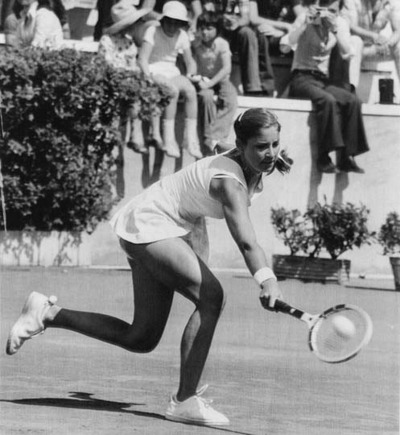
Born in 1954, Chris Evert will go down as one of the most successful players to have played the game of tennis. The American has been able to rack up a massive 18 major titles in her years, with the French Open proving to be her most successful.
Evert has won the French Open on 7 different occasions, more than any other women. The only women to have got close to her recorded is that of Steffi Graf, who has won a respectable 6 French Opens.
The pair actually tie in nicely with each other as Evert’s last win was in 1986, with Graf’s first win coming just 12 months later in 1987. Unfortunately, we never got to see these two greats battle it out in the final of the French Open, but after Graff’s victory in 1987, it certainly felt like a changing of the guard, with Evert’s domination slowly coming to an end at Roland Garros.
Graff went on to win 6 French Open titles and 22 majors in total over her illustrious career.
Most Successful Open Era Men – Bjorn Borg and Rafael Nadal
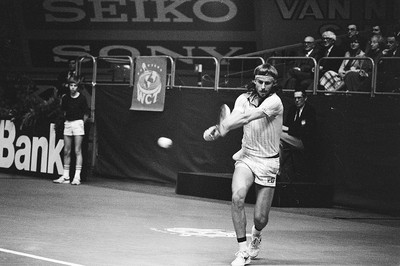
There are two men that stand head and shoulders above the rest when it comes to the French Open and that’s Bjorn Borg and Rafael Nadal. Between them that have been able to win 18 French Open titles and is a huge reason as to why the pair will go down as two of the true all-time greats.
The players played in two different generations though, but remarkably had very similar skill sets. Both were powerful players, but they were dogged and never gave up, two traits that are so vital to clay court tennis. They may not have been the prettiest on tour, but they knew how to win, something that can’t be taught and is just instinctive.
Borg won his first title in 1974, beating Spaniard, Manuel Orantes in 5 sets, after being 2-0 down. This proved to be the start of something special for Borg as he went on to win 6 of the next 8 French Opens. Some of his most memorable matches were that of his opening win, but also the marathon against Ivan Lendl in 1981, eventually winning in 5 sets a game that is dubbed to have been one of the best of all time. The 1981 victory over Lendl would also prove to be Borg’s last at the tournament.

Rafael Nadal grew on the clay courts in Spain, so his first win coming in 2005 wasn’t all that surprising against Mariano Puerta. It signified the start of something very special and a feat that has never been bettered, winning a total of 13 French Open titles, and as we write, there is likely more to come.
Nadal went on to win 4 in a row at the French and was starting to be dubbed as the ‘King of Clay’. But, in 2009 he lost a shock 4th round tie to Swede Robin Soderling, allowing long-time rival Roger Federer to win his one and only French Open title. The following year Nadal took clay court tennis to the next level, winning 5 French Opens in a row, a record for most consecutive wins in the French Open.
But, plagued with injury, Nadal was dumped out of the 2015 Open in the quarter-finals and then withdrew with an injury in the 3rd round in 2016. He came back in 2017 with a bang, and with almost no form leading up to the tournament, went on to win his 10th title and possibly his greatest achievement in his career, given the sheer volume of injuries he’d had and the time out the game that he had missed. Nadal followed this in each of the next three seasons winning his 13th French Open title in 2020, without dropping a single set in the process.